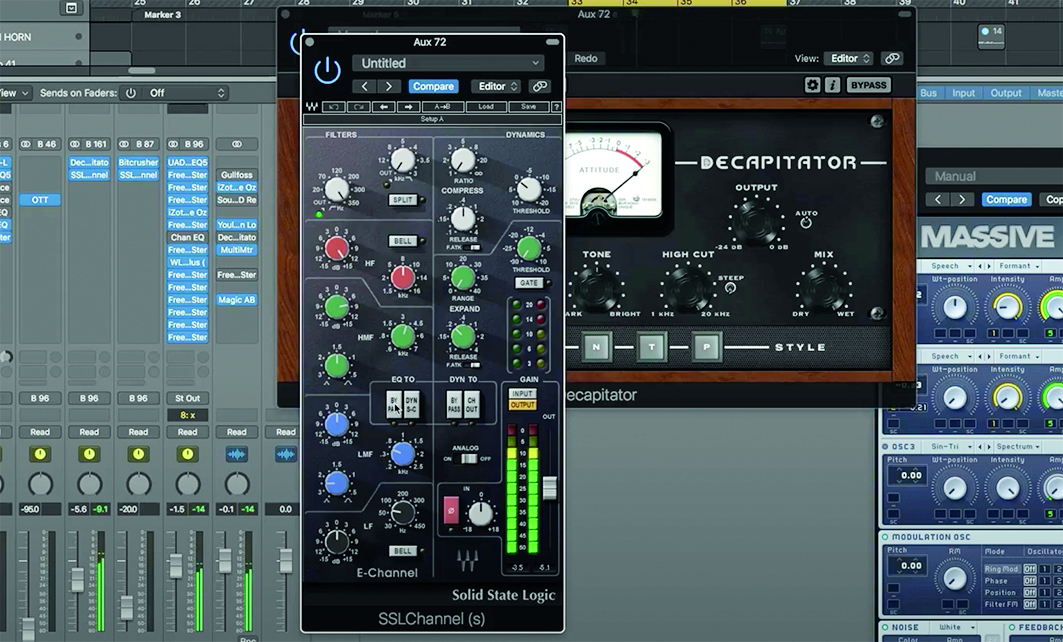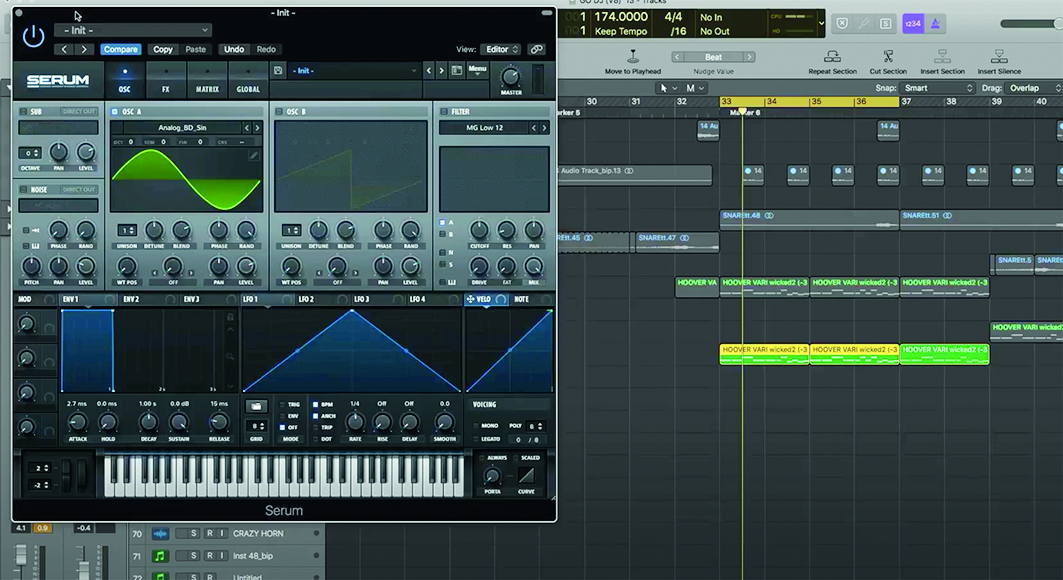The Breakdown: Danny Byrd on how he made the bassline for Selecta ft. D Double E
The D'n'B giant shows us around his studio and opens up his DAW to show us how he made the bassline for his latest release, for the first edition of The Breakdown
Bath-based producer Danny Byrd is a true lynchpin of UK drum & bass. A staple of influential label Hospital Records, Danny has released UK top 40 hits, a string of well-regarded albums and some of the most infectious remixes on the D&B circuit.
Key to Danny’s sound is a tendency to blend ideas from different genres – his best work often borrows ideas from R&B, hip-hop, old-school rave records and beyond.
Danny’s latest release, Selecta, is another great example of his genre-blurring approach. It started out life as a straightforward drum & bass club track – inspired by a sample CD from a certain Future Music Magazine – but then the track was brought to life by a lively vocal turn from grime figurehead D Double E.
In our new video series The Breakdown, we shoot artists and producers in the studio showing us the gear and techniques behind some of their best tracks. For this edition, we packed up our video cameras and went on a raid to Danny’s studio space to get a breakdown of Selecta ft. D Double E.
Tell us about the new single, Selecta… how did that all come about?
“Right before the last lockdown a friend of mine came to my studio in Bath and he had the idea for these horns that he’d heard on this Yello track. I was like, ‘I’ve heard those before! I think it was on a Future Music CD.’
“I managed to track them down, I had to get a copy from Discogs because it was a CD all the way back from ’95 or ’96. I managed to get the horns totally clean and just ended up rolling out the track in about a day, which is rare for me because I usually spend ages working on tunes. When you’ve got someone else in the studio though you can’t fuck around.
Want all the hottest music and gear news, reviews, deals, features and more, direct to your inbox? Sign up here.
We tested it in the car driving around Bath town centre blasting it past the bus station. That’s one of my tests…
“The basic three minutes of music were done in pretty much a day, and it is a buzz when you manage to do that. You don’t end up getting bored of it. We tested it in the car driving around Bath town centre blasting it past the bus station. That’s one of my tests… If you’re happy to play it really loud in an urban area then it’s probably got something to it.”
How did you end up getting D Double E on vocals for the track?
“Management really loved the tune and they were shopping it to some majors, which I just thought was crazy as I saw it as this fun drum & bass tune. Ministry were really interested though and asked if we’d thought about putting a vocal on it.
“I couldn’t really imagine a vocal working on it, but they came up with some ideas and one of them was D Double E and I was like, ‘oh yeah, I can hear that’. You almost end up doing an impression in your head over the top of it.
I have this thing, maybe it comes from arrogance or ego, where I always want to engineer my own sessions. I take pride in recording the vocals myself
“They booked a studio for us in London called Super Symmetry, which is a new place in East London. It’s a really nice place. We just got the vocal down in one night.
“My son was born literally the day before so I had to run straight from that to the session. It’s lucky he wasn’t born on the same day I guess. So I’ve obviously just gone through one of the biggest experiences of my life straight into another big
event – being in the studio with D Double E.
“I have this thing, maybe it comes from arrogance or ego, where I always want to engineer my own sessions. I take pride in recording the vocals myself. I took my Neve preamp down and made use of some of the nice kit they’ve got there, but actually that was one of those situations where I should have probably hired an engineer.
"When you’re in a studio that you don’t know and you’re trying to write, produce and engineer at the same time, it’s hard work. Although I do get a sense of pride when I listen to the tune and I can think that I engineered all that.”
I think you don’t realise how good a track is until you finish it
So, that all happened just before everything got locked down then?
“Things were starting to shut down then. It wasn’t hardcore lockdown but I couldn’t get a hotel or anything. It’s weird… as things have opened up again, you start taking things like that for granted. It was good that we could still do it in person though. Even if we did have some lockdown anxiety in the background.
How did the lockdown affect your music making? Were you still able to be creative?
“I forced myself to get into the studio every day like I imagine everyone else did. That usual thing of thinking ‘I’m going to get fit, I’m going to eat healthy, no more takeaways…’, then that goes out of the window after about a month [laughs].
“But the music making was particularly hard. I forced myself to do it but all the tracks were taking far longer to do. I look back on 2020 and I’m not sure if I wrote anything really good… I wrote some good stuff, but there was some mediocre stuff in there too.
Everyone knows how to start a track but no one can finish them. I’ve always found that hard too but you need to force yourself to do it
“But I’ve always had the belief with music that you have to finish off what you’re working on. So many up and coming producers or students at music colleges, they know how to start a track but no one can finish them. I’ve always found that hard too but you need to force yourself to do it.
“I think you don’t realise how good a track is until you finish it. Even if you’re not sure about it you can park it, come back to it in a few months and you may find you like it in a different way.”
How Danny Byrd made the bassline for Selecta ft. D Double E

Unusually for a drum & bass track, Selecta is in the key of C, which many producers tend to avoid. “It’s a terrible key because the lower octave is really shake-your-foundations low and the higher octave is too high to feel it.” Danny gets around this by doubling up the bass parts and using some careful effect processing.

The first bass part is a Reese bass part created by Danny in Massive. “The patch itself is really simple, with just two Speech oscillators detuned off of each other. I made a Macro to control osc 2 pitch, which lets me change the speed of the oscillation.”

Danny uses parallel distortion to add midrange bite to the sound. That comes from Soundtoys Decapitator with the drive control pushed to the max. Waves SSL Channel adds a boost to the highs and midrange on the parallel panel. “The distortion adds an extra layer to it,” Danny says. “It’s probably one of those things you can feel more than hear, but it gives it a bit of extra bite.”

“Because the track is in C, it needed an extra sub,” Danny tells us. He copies the notes of the bass part to an instance of Serum playing a simple sine wave. “I rolled off the top end from 240 then limited it with a Pro-L to get the level up.”

The final secret weapon is Soundtheory’s Gullfoss plugin applied to the lower bass part. “It’s kind of like an automatic EQ, it’s hard to describe. It’s like an AI tool that helps to level out all the frequencies a little bit more.”
Danny Byrd and D Double E’s new single Selecta is out now via Ministry Of Sound.


Future Music is the number one magazine for today's producers. Packed with technique and technology we'll help you make great new music. All-access artist interviews, in-depth gear reviews, essential production tutorials and much more. Every marvellous monthly edition features reliable reviews of the latest and greatest hardware and software technology and techniques, unparalleled advice, in-depth interviews, sensational free samples and so much more to improve the experience and outcome of your music-making.
